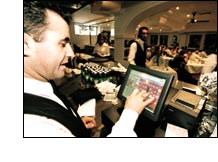Epsonow Magazine
Page 22 - Machiavelli: The prince of restaurants

For one of Sydney's highest profile restaurants, Machiavelli, Epson Point-Of-Sale technology is leading the fight in maximising turnover, in spite of one of the restaurant inductry's main concerns - shorter business lunches.
Gough Whitlam, Paul Keating, Peter Costello - these are just a few of the people who have had their photos hung on the walls of Machiavelli, one of Sydney's most famous restaurants. Since its opening on Clarence Street in 1988, Machiavelli has become a regular dining venue for other high profile Australians, including Mark Taylor, John Singleton, Ita Buttrose & Barry Humphries.
While its ambience, excellent food and wine play a major part in the restaurant's success, Machiavelli manager, Mr Italiano comments that attention to detail and premium service are every bit as important. Yet providing high levels of personal service has become more difficult over the years and, according to Mr Italiano, is the result of changing trends in diners' habits.
"It wasn't that long ago that people didn't think twice about starting a business lunch at midday and finishing anywhere up to six o'clock," stated Mr Italiano. "Now, most lunches last only two hours at the most."
For restaurants that have traditionally based much of their success on the business lunch trade, this means many things. Key among these is the need to maintain the same levels of profitability within a shorter timeframe. For Machiavelli, technology in the form of a combined Epson and PalmTeq solution represents that key.
Purpose-Built Solution
Developed and installed by PalmTeq, the solution features PalmTeq's WaiterPad system running on the Epson SR-600 Point-Of-Sale (POS) Terminal and hand-held PalmPilots, an Epson TM-U230 Kitchen Printer and two Epson TM-T88II Receipt/Coupon Printers.
For PalmTeq's New South Wales State Manager, Mr Stephen Gavan, the decision to propose the Epson-based solution to Machiavelli management came down to providing his client with equipment and software designed specifically for the hospitality industry.
"The TM-U230 Kitchen Printer is a perfect example of purpose-built equipment," stated Mr Gavan. "Before they designed the unit, Epson engineers worked with restaurant kitchen staff to devise a set of unique specifications. As a solution provider in the hospitality industry, I'm now able to offer a printer that can withstand shock, water, grease, heat - anything that a kitchen environment can throw at it."
Now at Machiavelli, order books have been replaced by WaiterPad electronic pads that transmit the orders via radio frequency communication.
When a waiter takes an order, it is entered into the WaiterPad and, once completed, sent automatically to the Epson SR-600 POS Terminal. There, the WaiterPOS software directs the order to any one of the three printers located throughout the restaurant.
According to Mr Italiano, even a five minute delay in taking an order can result in a patron not opting to buy that extra bottle of wine, or a coffee or after-lunch drink. "You can never put a definite figure on how much trade you lose by not having a waiter on hand to take an order," he said. "One thing you can be sure of though is that no-one likes to sit in a restaurant and become frustrated because there's no waiter available.
"With our new system, waiters can spend a lot more time at their stations. Orders are automatically printed out at the kitchen and salad area, which means our staff can concentrate on providing service and pay constant attention to customers.
"Added to this is the system's automatic tracking of orders," explained Mr Italiano. "One of the great things about this system is that when patrons go to pay for their bill, there's no chasing up to ensure all the dockets have been handed in by the waiters. Every item that's been ordered for a particular table is maintained on the WaiterPOS terminal, so when bills are called for we can be positive that it's 100 per cent accurate."
From PalmTeq's perspective, the benefit of the SR-600 is its open architecture. Based on an Intel Celeron 366MHz processor and running standard operating systems, such as Microsoft Windows 95/98/2000 and NT Workstation 4.0, developing software for the unit is a straight forward process.
"People in the restaurant industry don't have a lot of time to learn how to operate new equipment," explained Mr Gavan. "So when they see a solution based on the familiar Windows environment, it immediately becomes a lot more attractive.
"At a development level, it also means that we can easily modify our software that runs on the SR-600 to meet the specific needs of any restaurant."
Mr Gavan continued: "Another issue is that restaurants typically don't have room for large pieces of equipment; and Machiavelli is certainly no exception. At the bar, where bills are tallied and paid, shelf space is devoted to refrigerators and bottles. Putting in a PC, keyboard, monitor and mouse, then running all the cables is totally impractical.
"Because the SR-600 is an all-in-one unit, and has a 12-inch touch screen, which negates the need for a mouse or keyboard, it's really an ideal solution for the restaurant industry."
The real success of Machiavelli's new Epson SR-600-based system is best summed up by Mr Italiano: "When PalmTeq first came to me with this proposal, I kept telling them to come back - and I was just too busy to even sit down and talk. For our sake, though, I consider myself fortunate they kept coming back!"
